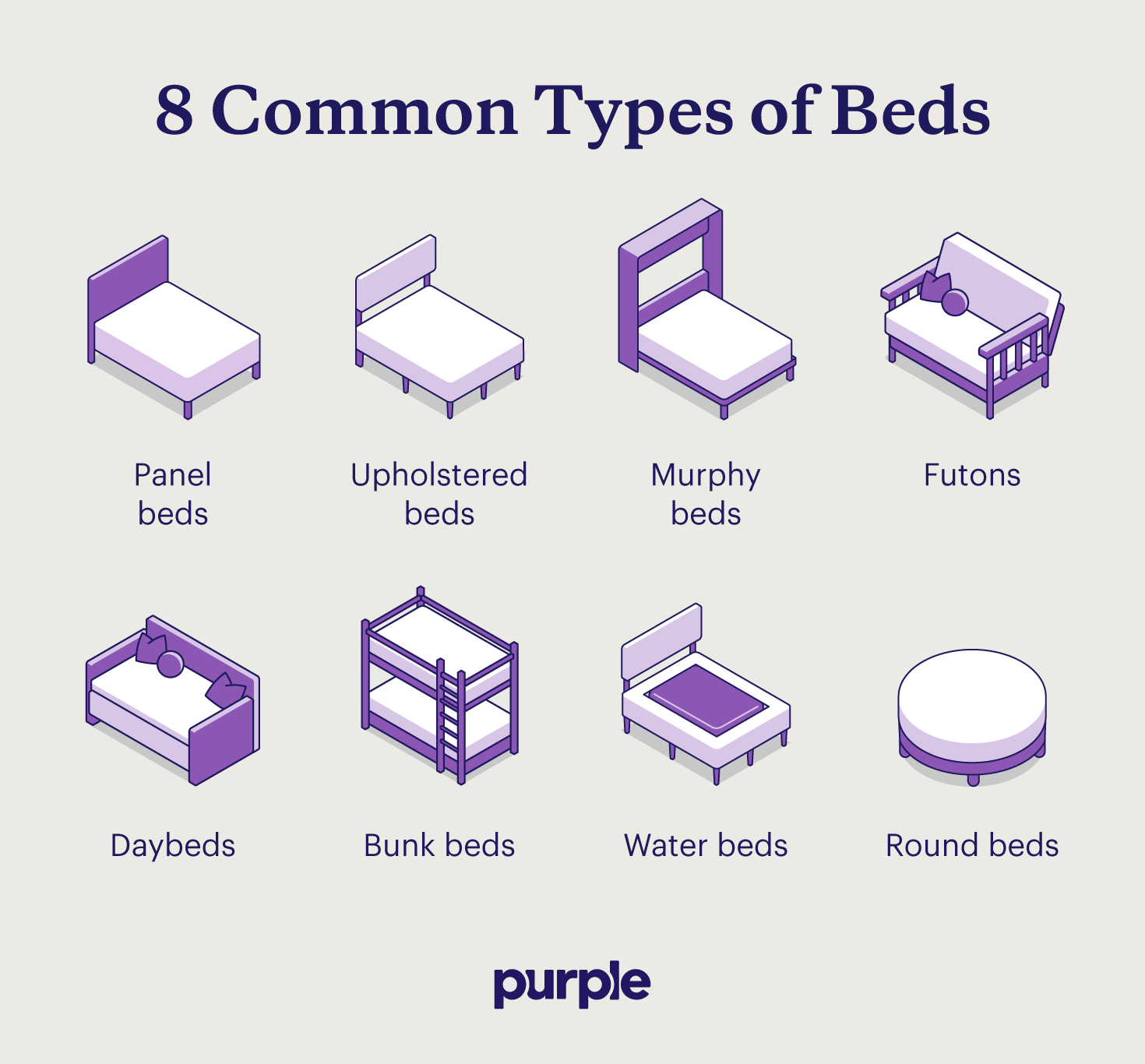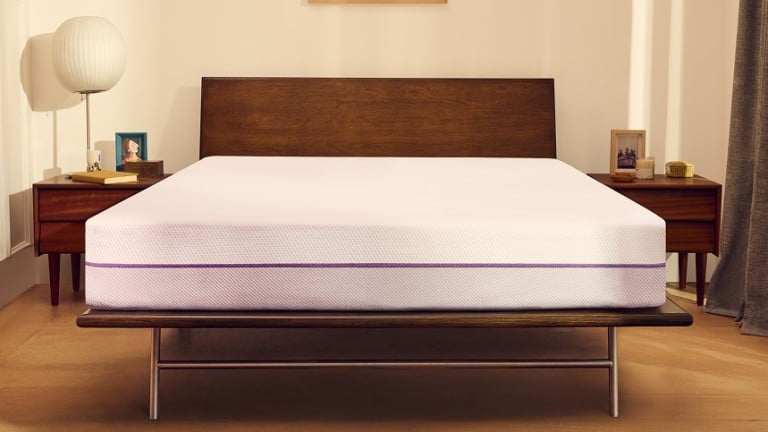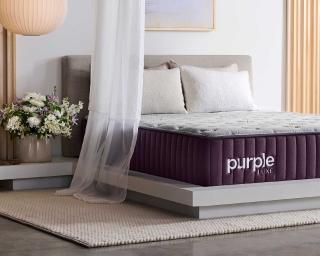Different Types Of Beds Explained: Sizes, Frames, and Styles
The right bed style can help improve your sleep quality and even add to your interior decor. To create an optimal sleep environment, you’ll want to find a style that accommodates your individual needs. But what’s the difference between these designs? What kind of frame should you have for your room size and aesthetic?
If you’re struggling to answer these questions, don't worry! Read our guide to different types of beds and styles. We’ll explain the differences between each one so you can choose the best one for your sleeping needs.
What Is a Bed Frame?
A bed frame is the railing of your bed. It provides support for your bed base, which in turn serves as the surface where you rest your box spring and mattress. Your frame raises the mattress foundation off the ground and helps evenly distribute mattress weight.
A bed frame traditionally includes a headboard, footboard, side rails, and legs. However, many modern bed frames have adapted a minimalist design that omits the legs, footboard, and headboard. This can give modern-style beds the appearance of floating.
Purple mattresses pair perfectly with Purple bed frames, so you’ll never second guess if your mattress will fit. Get essential, durable support and stability with a bed frame designed to maximize the benefits of your Purple mattress.
Sizes of Different Beds
You’ll want to choose a bed that’s not overwhelming in size and still leaves enough room for any other furniture. The bed is often the focal point of a bedroom and helps to tie the rest of the space together, so it’s essential to get the right fit. Below are the standard bed sizes produced by most mattress manufacturers using a variety of materials.
1. Twin
Dimensions: 38-by-75 inches
A twin mattress measures 38 inches in width by 75 inches in length. It's ideal for transitional beds for children and, due to its compact dimensions, a common size for bunk bed frames.
While great for dorms and children's bedrooms, it may not be the most comfortable size for adults to sleep in.
A single twin bed fits best in rooms that have about 70 square feet of floor space, or a 7 by 9.5-foot bedroom. You’ll have enough room for a comfortable night’s sleep, with space on all sides of your mattress for a nightstand, storage bench, or other furniture.
2. Twin XL
Dimensions: 38-by-80 inches
The twin XL mattress measures 38 inches wide and 80 inches long. Because it's five inches longer than the standard twin bed, it suits tall solo sleepers who want extra legroom.
While a queen bed is 22 inches wider and provides more room to spread out, a twin XL bed doesn't occupy as much space, making it a solid option for single sleepers or a guest bedroom.
Twin beds are a popular choice in shared children’s rooms. If you’re placing two un-bunked twin beds side-by-side, make sure the room’s width is at least 12 feet to allow for comfortable movement and space between the beds.
3. Full
Dimensions: 54-by-75 inches
The full or double bed size measures 54 inches in width by 75 inches in length. Its dimensions make it fairly roomy for single sleepers, but it may not be the comfiest size for couples who need some personal space.
Full mattresses are the same length as twin mattresses, but with an additional 16 inches of width, they can truly fill out a living space. Perfect for single sleepers who want a little more room to roll around, full size mattresses are ideal for slightly larger bedrooms with a few more feet to fill.
4. Queen
Dimensions: 60-by-80 inches
The standard measurement for a traditional-style queen size bed is 60 inches in width by 80 inches in length. While not as big as a king, it still has plenty of room for couples to sleep comfortably. Another advantage of this size is that it fits into most master bedrooms, as it only needs a minimum room space of 10 feet by 10 feet.
If you know you don’t want a king but you’re looking for an upgrade over the traditional twin, queens offer an ideal in-between option. Many couples prefer queen beds, as they offer sufficient snuggle room and independent space.
5. King
Dimensions: 76-by-80 inches
Also known as an Eastern king, a king size mattress measures 76 inches wide and 80 inches long. It's one of the largest bed sizes, most commonly manufactured in various designs with plenty of room to sprawl and move while you sleep. The luxurious extra space allows co-sleepers to share a bed with a child or pet with no fuss.
6. California King
Dimensions: 72-by-84 inches
A California king size mattress measures 72 inches wide and 84 inches long. This bed size is best for tall sleepers over 6-foot-4 who need extra legroom, especially if you shift sleeping positions at night.
The extra length means your feet won't dangle off the mattress edge while you sleep. It also has a generous width, which allows co-sleepers to snuggle up without feeling cramped.
Different Bed Types
When exploring different types of beds, take some time to consider your preferred bed design, which dictates the tone and mood your bed creates in your home. Beyond your bed’s size and frame, the design itself should complement your home and lifestyle.
Below are some of the most common bed styles and their unique characteristics.
7. Panel Beds
Panel beds are likely what you picture when you think of a bed in your home: a mattress and box springs set atop a bed frame with wooden panels or metal bars. The panel vs. platform bed distinction often comes down to the need for a box spring and the overall aesthetic.
8. Upholstered Bed
Upholstered beds feature a frame covered in fabric like velvet or linen. This provides a soft and often luxurious feel, creating a cozy and inviting bedroom atmosphere. They come in various styles, from sleek and modern to plush and traditional, and often feature padded headboards for extra comfort while sitting in bed.
9. Murphy Beds
Murphy beds rely on a strong hinge, which folds the bed into the wall until it’s ready for use. You’ll often find Murphy beds in smaller rooms or rooms that double as an office or a living room.
10. Futons
Futons are doubly useful as both couches and beds. A daytime couch can easily become a nighttime bed if you add a few blankets and a pillow with bed shams. You can easily fold and store a futon to make room for other furniture.
11. Daybeds
Daybeds are similar to futons — you can use them as couches, beds, or simply lounging areas. They can elevate a living space and even come in outdoor varieties to complete your outdoor environment.
12. Bunk Beds
Bunk beds, unlike loft beds, stack mattresses and frames on top of one another. Popular in children’s rooms and military-style living quarters, bunk beds help you make the most of your available space.
13. Waterbeds
Waterbeds contain water instead of more traditional foam, coil, or gel mattress interiors. Effective in calming sore muscles and evenly distributing weight, water beds can offer a surprisingly firm, relaxing sleep quality.
14. Round Beds
Round beds feature circular bed frames and mattress types. These beds are often the same length as a traditional king size mattress. Round beds are a favorite for individuals looking to creatively arrange bedroom furniture.
15. Hanging Beds
Hanging beds don’t rely on a bed frame or box spring at all. Instead, they hang from the ceiling. As long as they are installed correctly, hanging beds are a safe, effective sleep option and can help rock you gently to bed.
16. Air Mattress
An air mattress is a temporary inflatable bed made of durable plastic or rubber. People often use them for guests, camping, or as a short-term sleeping solution. While convenient, air mattresses won’t provide the same support and pressure relief as more permanent bed styles.
Air mattresses are not to be confused with air beds, a type of mattress most notably sold by Sleep Number.
17. Cots
Cots are lightweight, foldable beds designed for temporary sleeping arrangements. Often made with a simple frame and a stretched canvas or fabric surface, they are highly portable and easy to store, making them ideal for camping, guest use, or emergencies.
18. Wooden Bed
Wooden bed frames offer durability, versatility, and a timeless aesthetic. Crafted from various types of wood, these kinds of beds range from simple and rustic designs to ornate and sophisticated styles. Their solid construction often provides excellent support for a mattress and can contribute to the overall stability of your sleep setup.
19. Brass Bed
Brass beds are a bed style that adds a touch of vintage elegance and sophistication to a bedroom. With frames constructed of brass tubing and often featuring decorative details, these beds can range from antique-inspired designs to more contemporary styles.
20. Rattan Bed
Rattan beds bring a natural, bohemian, or coastal vibe to bedroom decor. Constructed from woven rattan or wicker, these beds offer a light and airy aesthetic. While visually appealing, the quality of the rattan determines its structural integrity and long-term durability. Be sure to assess the overall construction before purchasing.
21. Leather Bed
Leather beds offer a sleek, modern, or sometimes more traditional and luxurious bed style. Featuring a frame fully or partially covered in leather or faux leather, these beds can make a bold statement in a bedroom. Leather is generally durable and easy to clean, adding to the appeal of this type of bed, though the cost can be a significant factor.
Different Bed Styles
Beyond the basic construction, bed styles encompass a wide range of aesthetic designs that can dramatically influence the look and feel of your bedroom. From classic and timeless to contemporary and bold, understanding the different aesthetics will help you choose a bed that best complements your personal style.
22. Traditional Bed Style
The traditional bed style is known for its classic and enduring appeal. A traditional bed typically aims to create a warm and inviting atmosphere, making it a popular choice for those seeking a classic bed style.
Key elements:
- Familiar shapes
- Balanced proportions
- Time-honored design elements
23. Modern Bed Style
The modern bed style emphasizes clean lines, geometric shapes, and a lack of excessive ornamentation. Materials like metal, glass, and streamlined wood finishes are often used to create a sophisticated and uncluttered aesthetic.
Key elements:
- Sleek profiles
- Low-to-the-ground frames
- Focus on functionality
24. Farmhouse Bed Style
The farmhouse bed style brings a sense of cozy, rustic charm to the bedroom, often evoking a feeling of warmth and comfort. Farmhouse beds can incorporate details like shiplap, exposed wood grain, and neutral color palettes to create a relaxed and inviting atmosphere.
Key elements:
- Natural wood elements
- Simple lines
- Sometimes distressed finishes
25. Rustic Bed Style
Rustic bed styles celebrate natural, raw materials and rugged textures. They aim to create a connection to the outdoors, bringing a sense of natural beauty and unrefined charm to the bedroom.
Key elements:
- Unfinished wood
- Reclaimed timber
- May include metal accents or exposed joinery
26. Minimalist Bed Style
Minimalist bed styles are all about simplicity and functionality. They focus on essential elements and eliminate clutter. Minimalist beds prioritize creating a serene and uncluttered sleep environment, emphasizing quality over quantity.
Key elements:
- Clean, straight lines
- Low profiles
- Neutral color palette
27. Bohemian Bed Style
The bohemian bed style embraces a relaxed, eclectic, and free-spirited aesthetic. Overall, they encourage personalization and a comfortable, lived-in feel, creating a warm and inviting space.
Key elements:
- Natural materials like rattan or wicker
- Layered textiles with vibrant patterns
- Unique, globally-inspired accents
28. Cottage Bed Style
The cottage bed style exudes a light, airy, and romantic charm and creates a cozy and inviting atmosphere. They aim for a comfortable and whimsical feel, reminiscent of a peaceful countryside retreat.
Key elements:
- Floral patterns
- Soft pastel colors
- Painted or distressed wood finishes
29. Mid-century Modern Bed Style
The mid-century modern bed style often features tapered legs, low profiles, and the use of materials like wood, metal, and sometimes upholstery in muted tones or bold accent colors. They offer a timeless and sophisticated retro aesthetic.
Key elements:
- Clean lines
- Organic curves
- Focus on both form and function
30. Industrial Bed Style
The industrial bed style draws inspiration from factories and urban lofts, using raw materials to create a unique style. They often have a sturdy and functional appearance, sometimes incorporating details like pipes or metal grids. They bring an edgy and urban feel to the bedroom.
Key elements:
- Metal
- Exposed hardware
- Reclaimed wood
31. Mission Bed Style
The mission bed style is defined by its sturdy, straightforward design with strong horizontal and vertical lines and flat panels. Typically crafted from wood, these beds offer a sense of simplicity, durability, and handcrafted quality.
Key elements:
- Straightforward design
- Strong horizontal and vertical lines
- Flat panels
32. Scandinavian Bed Style
The Scandinavian bed style emphasizes simplicity, functionality, and natural elements, creating a bright and airy atmosphere. They often feature clean lines, light wood finishes (like birch or pine), and a focus on comfort and coziness with the use of soft textiles. Scandinavian styles promote a sense of calm and well-being in the bedroom.
Key elements:
- Simple design
- Light wood finishes
- Functionality
33. Contemporary Bed Style
The contemporary bed style is constantly evolving, reflecting current trends in design. These kinds of beds can encompass a wide range of materials and shapes. Contemporary bed styles are adaptable and often incorporate elements of other styles while maintaining a fresh and current feel.
Key elements:
- Clean lines
- Focus on comfort
- Sophisticated yet understated aesthetic
34. Kids Boutique Bed Style
Kids boutique beds focus on creating a whimsical, imaginative, and often themed sleeping space for children. These different types of beds can come in fun shapes, colors, and designs, sometimes resembling cars, castles, or other playful forms.
Key elements:
- Whimsical design
- Fun themes
- Playful forms
By Frame
The bed frame — a supportive structure that holds your mattress in place — is another important variable to consider when deciding on a bed style. Typically made of wood or metal, bed frames can help enrich your room’s aesthetic in a variety of subtle ways. The right type of bed frame adds sophistication to any living space and helps support your body while you sleep.
35. Platform Bed Frame
Platform bed frames create a lower-profile look by holding your mattress closer to the ground. Your mattress will rest on wooden slats or a solid slab of wood or metal, eliminating the need for a box-spring system.
36. Canopy Bed Frame
Canopy bed frames can vault your bed frame’s structure high above the mattress itself. Often, you’ll hang curtains or decorative sheets from a canopy bed frame, creating an additional privacy barrier in your room.
37. Wrought Iron Bed Frame
Wrought iron bed frames offer a simple, straightforward bed frame option. Metal frame elements can hold your mattress firmly in place for a durable, low-maintenance look and feel. Many wrought iron bed frames have vertical iron bars at the head and foot of the bed.
38. Loft Bed Frame
Loft bed frames can elevate your mattress above the ground. Popular in rooms for children and teens, lofted bed frames allow you to add a desk, play space, or even a second bed underneath your lofted mattress. Lofted bed frames are often made of wood and can resemble a bunk-bed style, though there are distinct differences between loft and bunk beds.
39. Trundle Bed Frame
Trundle bed frames help you prioritize storage in smaller spaces. These frames fit comfortably within another full bed frame. You can typically assemble a trundle bed frame in minutes, using the wheels to move it conveniently to any location. Trundle bed frames may be made of wood, metal, or both.
40. Sleigh Bed Frame
Typically made of solid wood, sleigh bed frames are exactly what they sound like: bed frames that closely resemble a sleigh. Sleigh bed frames aren’t quite as popular today as they once were, though they still offer a quality, timeless look for any residential space.
41. Ottoman Bed Frame
Ottoman bed frames create additional storage space in your room. They’re typically made with a wooden frame, a metal lifting mechanism, and an upholstered exterior. These frames utilize hydraulics that actually lift your mattress partially out of the frame itself, creating in-bed storage. If you need to store more stuff than will fit in under-bed storage, an ottoman bed frame can free up additional space for small and medium sized items.
42. Adjustable Bed Frame
In certain cases, you might also prefer an adjustable bed frame — a frame with hinges that allow you to enjoy a variety of different sleep positions. These adaptable bed frames provide head and foot elevation for sleeping, lounging, and even working in bed, making them a versatile addition to any bedroom.
43. Storage Bed Frame
Storage bed frames are designed with built-in drawers or compartments underneath the mattress platform, providing space-saving solutions for small bedrooms. They eliminate the need for separate dressers or under-bed storage containers, helping to keep your sleeping area tidy and organized.
44. Pull-Out Couch
A pull-out couch, also known as a sofa bed, functions as a sofa for seating during the day and converts into a bed for sleeping. Typically, a mattress is folded and stored within the couch frame. You can easily pull it out when needed, which makes it an ideal sleeping solution for guests or in multi-purpose rooms. The comfort level of a pull-out couch bed can vary depending on the mattress quality and frame design.
45. Divan Bed Frame
A divan bed frame has a sturdy, upholstered base that sits directly on the floor, often featuring built-in drawers for storage. The mattress sits flush on top of this base, eliminating the need for a separate bed frame and often a headboard (though one can be added).
46. Poster Bed Frame
A poster bed frame is a grand and often ornate bed frame with four vertical posts at each corner of the bed. These posts can extend significantly above the mattress and may be connected by decorative rails, creating a dramatic presence in the bedroom.
47. Folding Bed Frame
A folding bed frame is a highly portable and space-saving type of bed. It typically consists of a simple metal frame with a thin mattress that can be easily folded and rolled away for storage when not in use. Folding beds are ideal for temporary sleeping arrangements, like accommodating overnight guests in small spaces or for use in dorm rooms.
Whatever bed frame you choose, complete your set-up with the right mattress engineered for ultimate comfort.
Things To Consider While Buying A Bed
Searching for a supportive and well-made bed? If you’ve only just started looking around, the variety of bed styles can be overwhelming. Here are some basic considerations that will help you buy the best fit for your room size, personal preferences, including achieving the right firmness in your mattress.
Sleep Needs
Your individual sleep needs are a crucial factor in choosing the right bed. Consider the age of the primary sleeper: for babies and toddlers, safety and appropriate size are paramount, often leading to cribs and toddler beds. As children grow into teens, they’ll need more space, and you might consider beds that change as they get older, such as transitioning from a twin to a full or queen sized bed.
For adults, consider how many sleepers will share the bed — a single sleeper might need a twin or full, while couples can choose from a queen, king, or California king for ample personal space. Think about whether you need more room to stretch out or tend to move around a lot during sleep. Also, consider whether you run hot or cold, as this can influence the choice of mattress and bedding.
Bed Size
Make sure that your bed frame and mattress are matching sizes. If a bed frame is too large, there will be gaps on either side of your mattress. On the other hand, a mattress that's too big for your type of bed will fold and bend. This deforms the mattress, causes sagging, and shortens its lifespan. Understanding what size bed you should get is fundamental in choosing the right sleep setup.
Room Size
If you have a large bedroom, choosing a bed size is often a matter of convenience. You might select a king size mattress, one that allows more than enough space for natural nighttime movements. However, taller individuals should also consider the length, making the choice between a king vs. California king important. A California king is a longer, thinner option and offers an extra four inches of legroom compared to a standard king.
How large is your bedroom? Even if you find an elaborate bed frame more suitable to your aesthetic, you may find that there isn’t enough space to contain extra features like a canopy-style frame or side rails.
Every mattress type is slightly different in size and build. Consider your room’s size, height, and any existing items to help you decide on the ideal bed size for your home. To avoid purchasing a mattress that doesn't properly fit, you may want to measure your available space before considering different mattress dimensions.
When choosing a bed frame, it shouldn’t just fit your mattress snugly. It should also fit into your room with enough room to walk around as well as accommodate lamps and other furniture comfortably.
Height And Features
Another important consideration is the height of your chosen bed frame. Most bed frames will come up to a comfortable height roughly up to your knees. However, there may be other factors that can determine if you should get a frame that’s a few inches higher or lower.
For example, if your mobility is hampered, you may want a frame that’s not too high so you don’t have trouble getting in and out of bed. You may also choose a lower bed frame if you’re petite, as a too-high frame will make it easier for you to trip when you try to get in bed. If you plan to co-sleep with a pet or child, you should also consider their ease and comfort to avoid difficulties during bedtime.
For those who need extra space, there’s a major advantage to picking a higher bed frame. You can use the space under your frame for additional storage, which is a huge plus if your room size is limited. You’ll also want to ensure you choose a mattress that fits the dimensions of your bed frame.
Budget
A set budget is one of the easiest ways to narrow down your type of bed frame. There's a huge range in price depending on the style you choose. Some types of bed frames are as affordable as $100, while others can cost well over $2000.
You can find Purple bed frames and bases at different prices to suit your budget and needs. Adjustable bases range from $699 to $1895 for a queen size. Platform beds range from $299 to $750 for a queen. You can also purchase a queen size flat foundation for $399.
While it can be tempting to choose the least expensive types of bed frames, consider the materials being used and the quality of the frame. It's important to choose a long-lasting frame that comfortably supports your mattress.
Consider other costs, too, such as if the frame needs a box spring or not, and how much you should spend on a mattress. Note that you should not use a box spring with your Purple mattress; a platform bed or bed frame with a flat foundation will provide the best support.
Aesthetic
Once you've narrowed down your bed frame and room's respective dimensions, you'll want to consider which bed frame style suits your bedroom interiors. For example, you may prefer simple bed frames if you're keeping a minimalist look, but ornate bed frames may fit a more intricately styled room.
If you want a more sleek and modern room, plain metal or wooden bed frames may be more to your liking. Those who want an elaborate design for their room may consider getting frames for traditional canopy beds.
Whatever style you choose for your bed frame, it's wise to note your general preferred look so you can narrow down your options. A mood board is useful for picking between design styles. It will also make it easier to visualize how it will fit with your bedroom style.
Choosing The Right Bed for You
Choosing the right bed style and type of bed can be daunting because of the range of options available. Consider all the factors discussed, from the frame's material and design to ensuring the right firmness of your mattress. Before making a final decision, you should also try to test out a mattress in-store whenever possible to get a true feel for its comfort and support.
List your major considerations and talk to store specialists before choosing a bed frame and mattress. With careful deliberation, you can find a supportive, affordable frame and mattress combination that helps you sleep restfully at night.
Once you've found the perfect mattress to complement your chosen bed, explore the added benefits of personalized comfort and support with a Purple Premium Smart Base adjustable bed frame.
FAQ
Platform and panel beds are among the most popular bed styles because of their simple construction and ample support. Panel beds have a classic style but require a box spring or flat foundation to support your mattress.
Platform beds have become more popular in recent years because of their built-in foundation, though they often have a low-profile design that may not appeal to all sleepers.
There is a wide variety of different types of beds available, ranging from basic air mattresses and cots to more permanent options like panel, platform, and storage beds.
Mattress sizes typically include:
- Twin: 38 inches by 75 inches
- Twin XL: 38 inches by 80 inches
- Full: 54 inches by 75 inches
- Queen: 60 inches by 80 inches
- King: 76 inches by 80 inches
- California king: 72 inches by 84 inches
Currently, minimalist bed styles with clean lines and natural materials are trending, reflecting a desire for calm and uncluttered spaces. Additionally, upholstered beds with soft, inviting headboards in luxurious fabrics are gaining popularity for adding a touch of comfort and elegance to the bedroom.
There are a variety of bed styles to choose from, like the traditional style, characterized by classic shapes and often ornate details, and the modern style, which emphasizes sleek lines and functionality.
Farmhouse style offers a cozy, rustic feel, while mid-century modern brings a retro aesthetic with clean lines and organic curves.
Beds without headboards are often called platform beds. These types of beds feature a raised, level platform that directly supports the mattress without the need for a box spring, creating a low-profile and often minimalist aesthetic.
More To Explore
Level up your sleep routine with our most-loved products.












